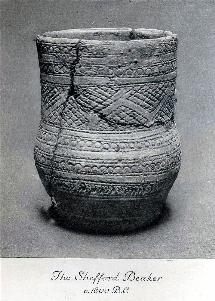Shefford before 1086

Shefford beaker BHRS Volume IX
Bedfordshire Historical Records Society Volume IX begins with a description of "The Shefford Beaker" [seen above]. It was found "between Shefford and Campton" in 1819, when the volume was written in 1925 the beaker was in "the Huntingdon Institution". The piece is 5½ inches high. It is often maintained that this form of pottery, very distinct from what went before, was made by a new people flooding into the British Isles at the start of the Bronze Age.
Ten years after the discovery of the Bronze Age beaker a Roman burial was discovered at Shefford. The burial was written on by David H.Kennett in The Bedfordshire Magazine [volume XII pages 201 to 203] in 1970. Thomas Inskip excavated a considerable quantity of charred bone and cremation ash was mixed with pottery, including some typically 1st century AD Samian ware imported from Roman France, or Gaul as it then was, glass and bronze objects. Inskip advertised his finds in a catalogue, mixed in with material he excavated from Stanford Bury in 1832. Much of the material found which is still extant is in the Cambridge Museum of Archaeology and Ethnology, although, like Inskip's catalogue, it is not now clear what came from Shefford and what from Stanford.
The burial was found somewhere near the later railway station and seems to have been of a high status man who lived in the second half of the 1st century AD. In the sixth century an Anglo-Saxon burial, complete with two fine gilt bronze saucers, occurred on the same site.

Roman relics catalogue heading [AD1748]
Thomas Inskip's catalogue of his finds at Shefford and Stanford Bury [AD1748] is as follows:
- "Two dozen Red Paterrae, Samian Ware, of various sizes from ten inches diameter to the smallest-sized cup. Several of them mutilated, others cemented, and some quite perfect, ornamented and plain; many having the maker's name across quite legible.
- One large Cinereal Urn, of peculiar shape, height 2 feet 8 inches.
- One smaller-sized Brito-Roman, of unburnt earth, ornamented. Perfect.
- One coarse Black Bottle. Perfect.
- One large Amphora. Cemented.
- One small Black Urn, ornamented with scroll work in high relief. Perfect.
Iron
- One large Iron Camp Tripod, turning on a swivel, with chain and hooks descending from the centre, height 4 feet 4 inches. Perfect.
- One large Iron Camp Fire Dog, representing a Stag's Head. A little mutilated.
- One ditto more prefect, with the bar belonging, unique.
- One Horse Shoe, with cross-bar. Perfect.
- One Iron Chain, used to lead Animals to sacrifice. Perfect.
- One Iron hammer, much oxydized. Perfect.
- One small Roman Knife, used by the Priest; sacrificial. Perfect.
- Two Spear Heads.
- Two very curious Iron Implements, with grotesque faces, Silenus's or Momes. Nearly perfect.
Jet
- Specimen of Lady's Armilla. Perfect.
Ivory
- One Tibicinal Musical Instrument, in five joints, with finger holes. A most curious relic.
Brass
- A very curious Brass Jug, with beautiful and highly ornamented handle, containing two Masks and Female Figures. Jug itself much corroded, but handle perfect.
- A Brass Dish, with very curious ornamented handles representing a Lion's and a Ram's Head. Cemented together.
- Two large Brass Fibulae, ornamented and gilt, probably used to fasten Military Habiliments. Nearly perfect.
- Three Brass Implements, presumed of dress, nearly resembling in shape a common Jew's Harp. One perfect.
- The Brass Hinge of a Roman Lady's Toilet Box, together with the two handles, two large Brass Rings, some ornamental Studs, and chased Brass-work; also a piece of the Wood of which the Box was formed. Hinge and Handles perfect.
- Ladies' Brass Fibulae. Nearly perfect.
- One Brass Celt.
- A Brass Serpent. Perfect.
- A very large Vrass Button. Perrect.
- Two Brass saucepans. Imperfect.
Glass
- The bottom and part of the neck of a large Glass Urn, the handle of which, representing a Fish's Tail, is perfect. Very imperfect.
- A beautiful Urn of Yellow Glass, radiated; of globular shape - no Anase. Perfect.
- A most splendid specimen of a Blue Glass Jug, of exquisite shape and workmanship, probably a Simpulum. Cemented, but perfect in appearance.
- A small Glass Funnel, of Greenish Hue. Cemented.
- Another Funnel of elegant shape, somewhat larger, and finer Glass. Cemented.
- A beautiful Urn of Violet-coloured Glass; of Grecian form, in pieces. Not yet cemented.
- A beautiful Blue Glass Lachrymatory. Quite perfect.
- A splendid Glass Bowl or Dish, 6 inches diameter, radiated very beautifully, of Aqua-marine colour. Quite perfect.
- A beautiful Lachrymatory of the same Glass, to match the preceding Vase. Quite perfect.
- Two radiated Blue Glass Beads. Perfect.
Stones
- Several Stone Rings, of various sizes, colours, and quality. Perfect.
- Two Rings (probably of Brass) supposed to be Ear-Rings. Imperfect.
- Several White Stones, and one of Black, used to play some Roman Game similar to Draughts. Perfect.
Silver
- One Zone Buckle of Silver. Quite perfect.
- One ditto, a duplicate. Imperfect.
- A pair of Silver Tweezers. Almost perfect.
- Roman Coins &c. &c.
N.B. One of the large Red Dishes was found mended, having been placed originally in the earth in that state, and is the more interesting; exceedingly so to the Antiquary.
Any Gentleman of Antiquarian Research may inspect the above.